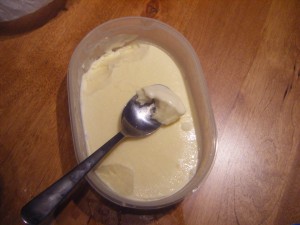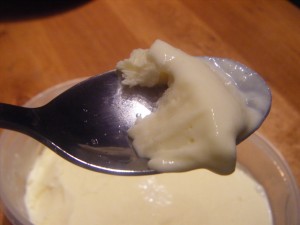So I must confess. I didn’t make the chocolate ice cream. I had my eggs and cream and, well, not the best French chocolate, but chocolate nevertheless, ready to go, when I read an even more intriguing recipe that I just couldn’t pass up. Fellow AAS staff member Paul Erickson sent along the following recipe for parmesan ice cream from Frederick Nutt’s The Complete Confectioner, 1789, and I just had to try it! (If anyone did give the chocolate recipes a shot, let us know how it turned out!)
 Parmasan [sic] Cheese Ice Cream.
Parmasan [sic] Cheese Ice Cream.
Take six eggs, half a pint of syrup,*
and a pint of cream; put them into
a stewpan and boil them until it begins
to thicken; then rasp three ounces
of Parmasan cheese, mix and pass
them through a sieve, and freeze it.
The preparation of the ice cream was surprisingly easy. Ice cream has always been the kind of dish I never imagined preparing myself, but when I pulled it out of the freezer, I was amazed that it actually looked like ice cream. Who knew I could make my own ice cream! Perhaps because there are appliances specifically for making ice cream, I’ve always imagined it was a much more complicated process than it really is. Granted the machines likely help with the whipping of the ice cream, thus adding air and making it more true to the ice cream consistency we’re used to, mine was pretty close to the real thing, no whipping or cranking necessary.
Then again, this is all coming from a cook in 2010. What truly made ice cream both difficult and novel in the 18th and 19th century was the work needed to actually freeze the ice cream. The hand cranking necessary, and needing to have the means to store ice and freeze the ice cream brings it to a whole new level. Combining the ingredients and popping it into the freezer and letting it sit overnight is nothing compared to what had to be done.
 Now about the flavor. The combination of cheese and sugar didn’t seem too far fetched at first. Even though parmesan isn’t exactly a mild cheese, my initial expectation was that it would taste a bit like cheesecake. When I finally tasted the final product, at first it simply tasted like ice cream. No particular flavor, but the consistency and sweetness was there. But then a moment later was the flood of cheese flavor. Not horrible, but definitely not what I was expecting – frozen cheesecake it certainly was not! When ice cream was still a novel dish, I wonder if expectations were not dead set on a sweet treat. Perhaps folks were more experimental with their ice cream, as opposed to my expectations, having grown up with the soft serve twist.
Now about the flavor. The combination of cheese and sugar didn’t seem too far fetched at first. Even though parmesan isn’t exactly a mild cheese, my initial expectation was that it would taste a bit like cheesecake. When I finally tasted the final product, at first it simply tasted like ice cream. No particular flavor, but the consistency and sweetness was there. But then a moment later was the flood of cheese flavor. Not horrible, but definitely not what I was expecting – frozen cheesecake it certainly was not! When ice cream was still a novel dish, I wonder if expectations were not dead set on a sweet treat. Perhaps folks were more experimental with their ice cream, as opposed to my expectations, having grown up with the soft serve twist.
Now that I know how easy is it to make home made ice cream, with our modern conveniences, of course, I’m certain I’ll be trying out many more recipes. I’ll just be staying away from the cheese!
